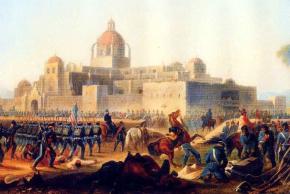Defying a war of conquest
, co-host of Radio Free Eireann on WBAI in New York City and a veteran organizer for Irish political prisoners, tells the story of the St. Patrick's Battalion.
THE ST. Patrick's Battalion, or San Patricios in Spanish, was made up of Irish soldiers who left the U.S. Army to fight for Mexico in the Mexican-American War starting in 1846. They came from Ireland in the middle of a famine in which a million people died and 2 million fled the country. Irish people who were already desperately poor could only leave or die.
Many of the San Patricios enlisted or were drafted into the American army literally right off the boat from Ireland. Arriving penniless, they were promised generous pay and land after the war. Instead, they met anti-Irish bigotry from Nativist American officers who often prohibited them from attending mass or practicing their religion.
When they arrived on the Mexican border, they found that the American army looked very much like the British army of occupation in Ireland. They saw Mexico, like Ireland, as a poor nation being invaded and oppressed by a rich and powerful neighbor. Kerby Miller, the preeminent historian of the Irish emigration to America, wrote: "They realized that the army was not fighting a war of liberty, but one of conquest."

Commanded by John Riley of Galway, the Irish formed the St. Patrick's Battalion of the Mexican Army. They created their own green banner, inscribed with "Erin go Bragh!" (Ireland Forever) and "Libertad por la Republica Mexicana."
The San Patricios fought with bravery and skill throughout the war. Like African American soldiers in the Civil War, they knew they could expect no mercy if they were captured.
They served initially as artillerymen. This was critical because many, like Riley, were already veteran gunners, unlike their Mexican comrades who had virtually no artillery training. Because of the San Patricios, at least two major battles were fought to a draw, instead of being lost by the outnumbered and outgunned Mexicans. At the Battle of Monterrey, the San Patricios' accurate cannon fire turned back three American charges.
TOWARD THE end of the war, the San Patricios became an infantry battalion. At Churubsco, the next to last battle of the war, the San Patricios repeatedly refused to surrender. Twice, Mexican soldiers hoisted white flags. Twice, the San Patricios tore them down. Finally, running out of ammunition, they were overwhelmed and captured.
The captured San Patricios were tortured or hung. Sixteen, including John Riley, were found to have deserted before the U.S. declared war on Mexico. They were given 50 lashes on their bare backs, a "D" was branded on their cheeks, and iron yokes were attached to their necks for the rest of the war.
Forty-eight were sentenced to hang. The last 30 San Patricios were hung on September 13, 1847, at Chapultepec, the last battle of the war. They were placed on wagons overlooking the fort, with nooses around their necks, to be executed as soon as the American flag replaced the flag of Mexico. Francis O'Connor--whose legs had been amputated the previous day--was propped up in a wagon to hang.
The San Patricios were kept standing on the wagons for two hours. Just before the end, they cheered the Mexican flag. An eyewitness described them: "Hands tied, feet tied, their voices still free." At 9:30 a.m., as the U.S. flag appeared, the horses were whipped, and the men died.
Today, the San Patricios are honored throughout Mexico. Subcomandante Marcos of the Zapatistas issued a St. Patrick's Day call for international solidarity in the name of the San Patricios:
When Mexico was fighting, in the last century, against the empire of the bars and crooked stars, there was a group of soldiers who fought on the side of the Mexicans and this group was called "St. Patrick's Battalion."
And so I am writing you in the name of all of my compañeros and compañeras, because just as with the "St. Patrick's Battalion," we now see clearly that there are foreigners who love Mexico more than some natives who are now in the government. And we hear that there were marches and songs and movies and other events so that there would not be war in Chiapas, which is the part of Mexico where we live and die.


